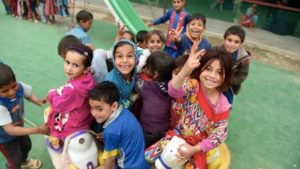Refugee children adjust well to life in Australia – research
 The majority of young refugees resettled in Australia in recent years are adjusting well to their new lives and thriving, according to new research.
The majority of young refugees resettled in Australia in recent years are adjusting well to their new lives and thriving, according to new research.
The study, which looked at almost 700 refugee children, found the majority were living with both parents and had adopted English in addition to using their own language at home.
The children reported high levels of physical health and activity and engagement in extracurricular activities, such as sport or dance.
There were low levels of school absenteeism and high ratings of school achievement. Up to a quarter reported school-based awards and achievements.
Researchers at the University of Melbourne analysed data on 694 children aged 5-17 years and 426 primary caregivers, from the Building a New Life in Australia (BNLA) survey conducted between October 2015 and February 2016. The majority of the children had spent less than 12 months in Australia before answering the survey questionnaire.
“The results indicated that refugee children and adolescents are adjusting soundly to their new lives in Australia, at a time when the acute stressors of resettlement are likely to have abated,” the study said.
“The findings from our study show that, when considered as a group, relative to non-refugee Australians, this cohort of refugee children and adolescents were generally adjusting well,” it said.
“In fact, 76–94 percent of this sample reported functioning in the normal ranges of adjustment.
“We found that refugee children and adolescents did not differ from Australian age-and gender-matched norms, with exception of 14- to 17-year-old refugee boys, who reported overall higher levels of adjustment than Australian norms,” the report said.
But it found that 14- to 17-year-old girls reported lower overall adjustment than Australian peers.
The report suggested that a reason for this may be that girls may be at higher risk for social and emotional difficulties than boys.
“It is possible girls may have more difficult or negative migration experiences, with a higher risk for certain traumatic events than boys, such as sexual violence,” it said.
“Further, girls may experience greater difficulties than boys in the post-migration setting, for instance, through prejudice or gender discrimination.
“Finally, adolescent girls may be more prone to internalising emotional difficulties and such risk may be particularly pronounced in refugee girls,” the report said.
It said that as an overall population though, refugee children and adolescents appeared to be functioning soundly relative to Australian peers.
“This finding that young refugees function comparably despite potential adversities is suggestive of resilience among this group and might be explained in two ways,” the report said.
It suggested two reasons for this.
One was related to the length of time since arriving in Australia and opportunities to acculturate within school and community contexts.
The other was the screening and selection processes that Australia engages in its humanitarian migration pathway.
The report said the majority of young refugees in the sample had not arrived as asylum seekers, had not spent time in multiple refugee camps, and arrived accompanied.
See the full research here: https://bmcmedicine.biomedcentral.com/articles/10.1186/s12916-018-1124-5
Laurie Nowell
AMES Australia Senior Journalist












